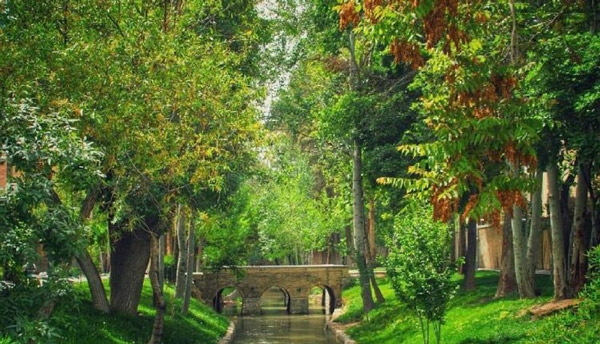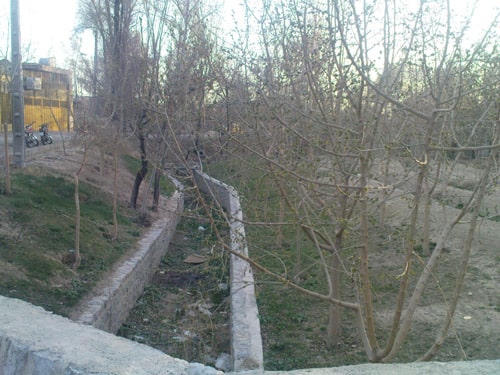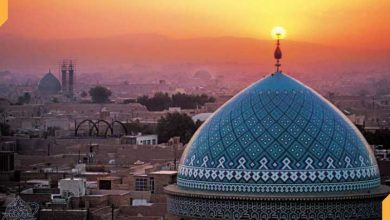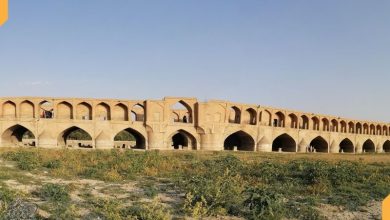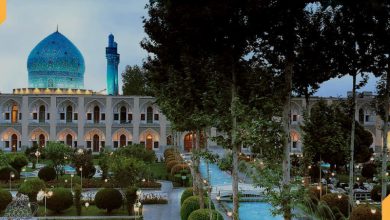Isfahan’s Water Channels (Madi)

In this article, we refer to many items about the watery channels in the level of Isfahan city; like the watery streams(Madi) of Isfahan. There are many photos of these streams in this article that by seeing them, you are encourages to visit them.
In general, 154 streams (Madi) are separated from Zayandeh rood, which in the Sheikh Bahai’s scroll, the number of these streams is 78, that 47 streams branch from the left and 38 streams from the right. This division is based on 33 primary shares, and each share also has other subdivisions.
Of these numbers of streams (Madi), ten stream are now flow in the current context of the city of Isfahan that the direction of their movement is from southwest to northeast, and according to another subdivision named “Lat”, all lands, gardens, and private houses were irrigated.
The name of the streams (Madi) that covered the city of Isfahan during the Safavid period, in the north of the river from bottom to top, include: Niasaram, Farshadi, Fadan, Tiran, Qomish and in the south of the river: Shayej, Nayej, and Abdullah Khan. In the past, Zayandeh rood was the southern extent of the city, but now, the neighborhoods of Jolfa, Sichan, Hossein Abad, Takht-e-Foolad, Kole Parcheh, etc., have become part of the city, and these streams (Madi) are located in the central part of Isfahan. In the following, these streams will be introduced.
Mir Seyed Ali Jenab in his book with the title of “Al- Isfahan” said:
“from the river with the aqueducts that it’s water with more and less distance, makes the farming irrigate; the water is that these aqueducts are called the maddi“.
“the complex way of the division of water was based on two principles of time and place by this people, was due to a deep thought that delivered the water to all of the villages according to the need and caused such a prosperity and freshness”.
Still, now the neighborhoods of Jolfa, Sichan, Hosseinabad, Takht-e-Foolad, Kole-e-Pacheh, etc., have become part of the city, and these streams are located in the central part of Isfahan. In the following, these streams will be introduced.
Niasaram Stream (Madi):
This Stream (Madi) is separated from the river by Marnan Bridge and joins it from Saeb Street, Nahr Joye Asiyab and flows along Saeb Street by Bagh Jannat neighborhood to the east and it crosses parallel to the river from Shahpour streets, Ordibehesht, Azar, Shamsabadi, Chahar bagh, Ferdowsi, Tobacco Factory, Chahar bagh Khajoo Street, Wool Factory (the current location of the broadcasting of the center of Isfahan) and then moves along Moshtagh Street to the east and passes from Bozorgmehr Street and irrigates the agricultural lands of the east of Isfahan.
Farshadi stream (Madi)
This creek is Separated from the top of Niasaram stream (Madi) and near the Najenan village, from the river and passes through the Atash street and the neighborhoods of leniyan, Chahar sogh, Shams Abad and passes alongside the Niasaram stream (Madi) from the streets of Shahpour, Ordibehesht, Azar, Shams Abadi and Chahar Bagh and then, enters to the Soltani school and Abbasi caravansary (the current hotel of Abbasi) and also passes through Ostandari street, Hasan Abad gateway and Malek street and a branch of it joins to the Niasaram stream (Madi).
Fadan Stream (Madi)
This stream (Madi) is separated from the village of Tey Abad in the top of the Najnan from the river and after passing through Khayam street, Lobnan mosque, the neighborhood of Shams Abad, and the streets of Shahpour, Ordibehesht, Sheikh-e Bahai, and Taleghani, reaches to the neighborhood of Darvazey-e Dolat and it divides into two branch there:
a branch in the northeast reaches to the neighborhood of Dar Dasht and the other branch enters to the Chehel Sotoun garden, after passing from Chahar Bagh and passes through the Teimouri hall, Sepeh street and the north of Naghsh-e Jahan square, enters to the school of Molla Abdollah and passes through Mokhles caravansary.
Then, it divides into three branches: 1. the mosque of Sarutaghi, offspring of Ahmad 2. Zolomat mosque, the alley of kermanies, the south part of the neighborhood of Jouybar 3. The school of great Jadeh, the caravansary of Sarutaghi, Golbahar neighborhood, Hateph Street, offspring of Esmail, offspring of Jafar, Shoaba mosque, and the tomb of Nezam-ol Molk. Now, these branches don’t exist and they were flow in the past.
Jouysha stream (Madi)
This stream (Madi) was allocated to the royal gardens and passed through the mosque of Lobnan and the neighborhoods of Mahallat-e Chahar Soghe Shirazi, Mostahlak, Shams Abad and Bahai Street.
A branch of it passes through Farshadi stream and the other branch from Chehel Sotoun Palace, Goldasteh garden, Hasht Behesht garden, the place of Khorshid hospital and entered to the Naghsh-e Jahan square after passing from Poshte Matbakh Street and after turning the square to the Fadan stream (Madi), was connected in the school of Molla Abdollah.
Tiran stream (Madi)
This stream (Madi) that is located in the western extent most, the capacity of it, is equable as Farshadi stream and irrigates the neighborhoods of Chaharsou, No and Bid Abad from the west side of the city and then goes to the north of the city and irrigates Ghara-e Mornan, Ahangaran and their farms.
Many branches were ramified from this stream (Madi) that a branch of it, operating Asian and pours in to the branch stream of Fadan.
Qomesh (Qomish) stream
The place of tributary of the Qomesh creek from the river is higher than the mentioned streams. This creek is very significant, and the village of Qara Marbin which is near to the cities, like Nasrabad, Gortan and Jozdan, is indebted to the generosity of this creek.
The water of this Stream is more than the other streams and lesser than Niasarm. The importance of this creek is that if there is a drought, or if the river does not have any water, enough water will come out from the springs that are in its path, and it will form a river with enough water.
This creek in the near of the Gortan Mosque is divided into two parts, and the waterfalls from both sides and the mild air and the mass of the trees has such a condition that it is an example of Sadr al-Din Khanjadi’s poem that said:
“Marbinet ke noskhe eram ast Aftab-e an dar ou deram deram ast”
The streams (Madi) that flow in the southern part of the river are as follows:
Black creek stream (Madi)
This creek originates from the top of Pirbakran, passes through Farahabad and the south of Hezar Jerib, and most of the water tanks of Takht-e-Polad, Mosalla Mosque, our Tekyeh in Shahzadeh use its water.
Now, this Stream (Madi) passes through the lands of the army after Farahabad, then enters the officer’s college, and then inside the University of Isfahan, irrigates its lands and green space of it; but unfortunately, after the university in the Hezar Jerib street, it pours into the sewerage of Isfahan.
This is primarily due to the growth of construction in the recent years in the Mardavij region.
Shayej stream (Madi)
Shayej stream (Madi) starts from the side of the river, above the Marnan, irrigates Dastgerd and Hossein Abad. In front of the Farahabad, it is divides into two parts (Lats) that one branch of it goes to Sichan, and the other branch, which is known as “Ab- e Devist-o Panjah” irrigates the lands around the Vatan factory and Kole Parcheh.
Nayej Stream (Madi)
The origin of Nayej Stream is in Marnan estates, and it irrigates Jolfa, Sichan, Zereshk garden, southern estates and Si-o-Se Pol Bridge and also around the Shahreza and Riyaf factories.
Bloody Stream (Madi)
This Stream is separated from the river with the same name, near the Khajoo Bridge, and after crossing from the Abshar Street, and after Bozorgmehr Bridge, it flows again into the river.
Abdullah Khan stream (Madi)
Abdullah Khan’s gutter, flows into the river near the Marnan Bridge, and its source is approximately 1000 meters higher and is located in the Marnan estate, and its mills and groves known as “Three Mills” use its water.
In addition to the streams (Madi) mentioned above, there have been several springs were flowed in the city that Unfortunately, due to improper abstraction of groundwater, most of them have dried up, and only their canal remained in the town. These springs include: Cheshmeh Baqer Khan (Khorasgan), Cheshmeh Rahravan (Daran), Cheshmeh Shams Abad, Cheshmeh Modarres, Cheshmeh Shah Pasand, Cheshmeh Tameh.
Kaempfer, beside other tourists, had explained the maddi in detailed and writes:
“Zayandeh Rood was constructed a dam in a long distance and divided to a manufactured network and a part of it, was consumed for the irrigation of the farms which are outside of the city and a part for supplying the water of swimming pools, countless pools of castles and the residential houses.”
The special branches of irrigation have technical, specific terms that the first branches to any number are called “Maddi”. the branch that it is ramifies from that, is called table.”
Conclusion:
In the past, streams also had a spring that boiled in addition to the Zayandeh River, and when the Stream was dried, there was saltwater at the bottom of the creek, but due to disregard for stream(madi) purification, those springs are complete, and their boiling point is gone.
 Which of the pointed streams (Maddi) did you have seen? If you have a special or interesting experience from this streams in Isfahan, Share with us.
Which of the pointed streams (Maddi) did you have seen? If you have a special or interesting experience from this streams in Isfahan, Share with us.

